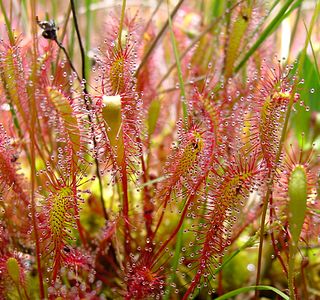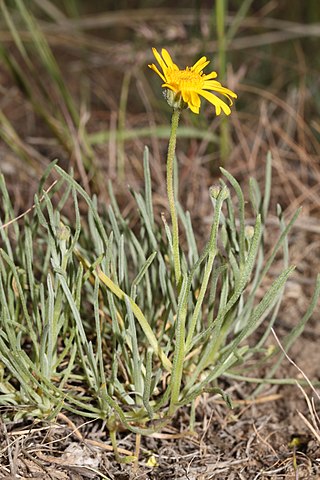
Rooibos, or Aspalathus linearis, is a broom-like member of the plant family Fabaceae that grows in South Africa's fynbos biome.

Drosera anglica, commonly known as the English sundew or great sundew, is a carnivorous flowering plant species belonging to the sundew family Droseraceae. It is a temperate species with a circumboreal range, although it does occur as far south as Japan, southern Europe, and the island of Kauai in Hawaii, where it grows as a tropical sundew. It is thought to originate from an amphidiploid hybrid of D. rotundifolia and D. linearis, meaning that a sterile hybrid between these two species doubled its chromosomes to produce fertile progeny which stabilized into the current D. anglica.

Montia is a genus of plants in the family Montiaceae. Species in this genus are known generally as miner's lettuce or water chickweed. All of the species in the genus have edible leaves. It is found worldwide, except in Asia.
Melicope pallida, the pale melicope, is a species of tree in the family Rutaceae. It is endemic to the Hawaiian Islands. It is threatened by habitat loss. It is a federally listed endangered species of the United States. Like other Hawaiian Melicope, this species is known as alani.

Collomia linearis is a species of flowering plant in the phlox family known by the common names tiny trumpet and slenderleaf collomia. This tiny wildflower is native to North America where it is fairly widespread across the north and west. It is an annual herb, rarely exceeding 30 centimetres (12 in) in height, with a velvety erect stem bearing long, narrow green leaves. Atop the stem is a cluster of up to 20 white or light pink flowers, each about a centimeter across. Each has five small rounded petals and stamens tipped with anthers bearing white pollen.

Erigeron linearis is a species of flowering plant in the family Asteraceae known by the common name desert yellow fleabane or narrow leaved fleabane.

Calyptridium umbellatum, synonym Cistanthe umbellata, is a species of flowering plant in the montia family known by the common name Mount Hood pussypaws or — especially outside the Pacific Northwest — simply pussy-paws.
Erythranthe montioides is a species of monkeyflower known by the common name montia-like monkeyflower. It is native to the Sierra Nevada and its foothills in California, and it has been observed in the mountains near Carson City, Nevada. It grows in moist areas in the mountains and disturbed, rocky soils. It was formerly known as Mimulus montioides.

Montia chamissoi is a species of flowering plant in the family Montiaceae known by the common names of water minerslettuce, water montia, Indian lettuce, and toad lily. It is native to much of western North America from Alaska to the southwestern and central United States and also in British Columbia. It grows in moist to wet soils in a variety of habitat types, such as meadows, wetlands, plains, and montanes. It is sometimes aquatic, anchoring in mud and floating in water.
Montia diffusa is a species of flowering plant in the family Montiaceae known by the common names branching montia and spreading miner's lettuce native to North America.

Montia howellii is a species of flowering plant in the family Montiaceae known by the common names Howell's miner's lettuce and Howell's montia. It is native to western North America from British Columbia to northern California, where it grows in moist to wet habitat, including vernal pools and meadows. It sometimes grows in shallow standing water such as puddles. The species is known from fossilized seeds recovered from sediments of the Pleistocene Tomales Formation and from a small paleoflora at San Bruno. Further, Daniel Axelrod discussed Montia howellii as one of the biogeographically significant species comprising the Millerton Palaeoflora at Tomales.

Montia parvifolia is a species of flowering plant in the family Montiaceae known by the common names little-leaf miner's lettuce, small-leaved blinks and small-leaved montia. It is native to western North America from Alaska to California to Montana, where it grows in moist to wet areas in several types of mountain habitat.
Petalonyx linearis is a species of flowering plant in the family Loasaceae known by the common name narrowleaf sandpaper plant. It is native to the deserts of eastern California, western Arizona and northwestern Mexico, where it grows in scrub and other habitat. It is a rounded clumpy subshrub made up of many rough-haired, erect stems up to a meter tall.

Phacelia linearis, the linear-leaved phacelia or threadleaf phacelia, is a species of phacelia. It is native to western North America from western Canada to Wyoming to northern California, where it grows in forest, woodland, open scrub, and other habitat. It prefers sandy soils.

Persoonia linearis, commonly known as the narrow-leaved geebung, is a shrub native to New South Wales and Victoria in eastern Australia. It reaches 3 m (9.8 ft), or occasionally 5 m (16 ft), in height and has thick, dark grey papery bark. The leaves are, as the species name suggests, more or less linear in shape, and are up to 9 cm (3.5 in) long, and 0.1 to 0.7 cm wide. The small yellow flowers appear in summer, autumn and early winter, followed by small green fleshy fruit known as drupes. Within the genus Persoonia, it is a member of the Lanceolata group of 58 closely related species. P. linearis interbreeds with several other species where they grow together.
Dubautia latifolia is a rare species of flowering plant in the family Asteraceae known by the common name koholapehu. It is endemic to Hawaii where it is known only from the west side of the island of Kauai. Like other Dubautia this plant is called na`ena`e.
Exocarpos luteolus is a rare species of flowering plant in the sandalwood family known by the common names leafy ballart or heau. It is endemic to Hawaii, where it is known only from the island of Kauai. There are eight populations remaining, for a total global population of only 39 individuals. The plant was federally listed as an endangered species of the United States in 1994.

Dicranopteris linearis is a common species of fern known by many common names, including Old World forked fern, uluhe (Hawaiian), and dilim (Filipino). It is one of the most widely distributed ferns of the wet Old World tropics and adjacent regions, including Polynesia and the Pacific. In parts of the New World tropics its niche is filled by its relative, Dicranopteris pectinatus.

Erythranthe gemmipara is a rare species of flowering plant in the family Phrymaceae, known by the common name Rocky Mountain monkeyflower. It is endemic to Colorado in the United States, where there are eight known occurrences. It was formerly known as Mimulus gemmiparus.
Ambrosia linearis is a species of flowering plant in the family Asteraceae known by the common names streaked bur ragweed, Colorado bursage, linear-leaf bursage, and plains ragweed. It is endemic to east-central part of the state of Colorado in the United States, where it occurs in Elbert, Pueblo, El Paso, Cheyenne, Crowley, Kiowa and Lincoln Counties.













